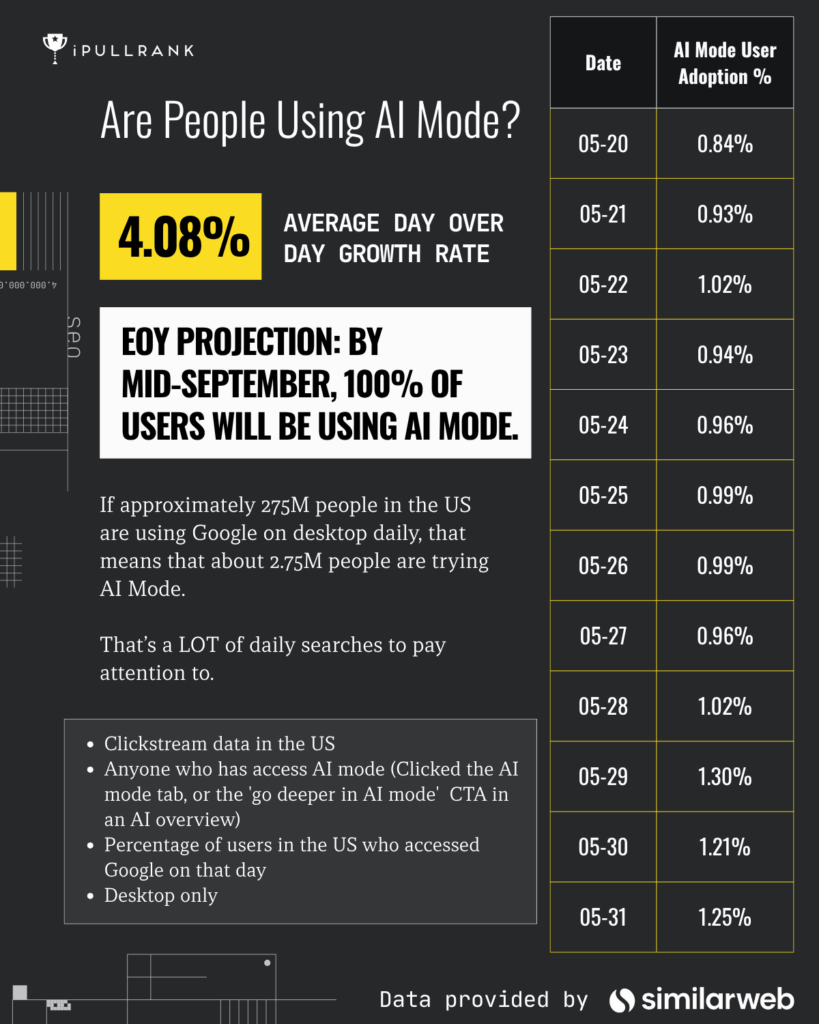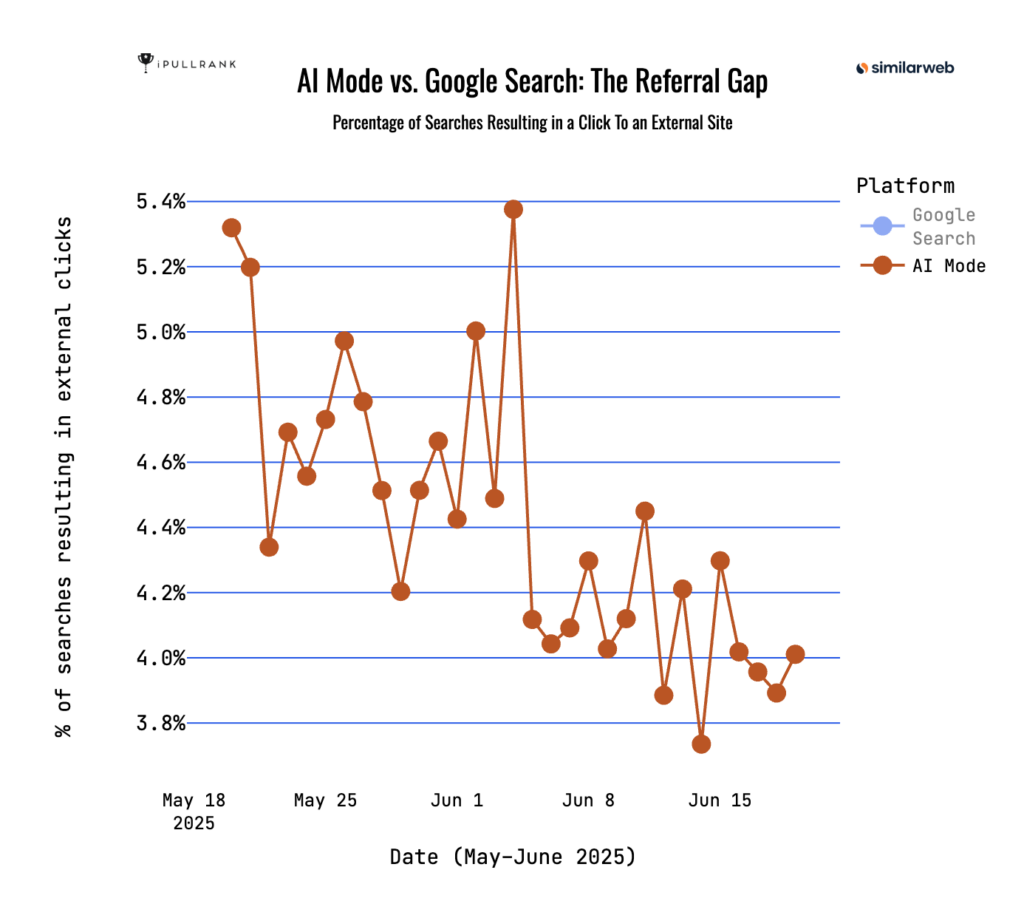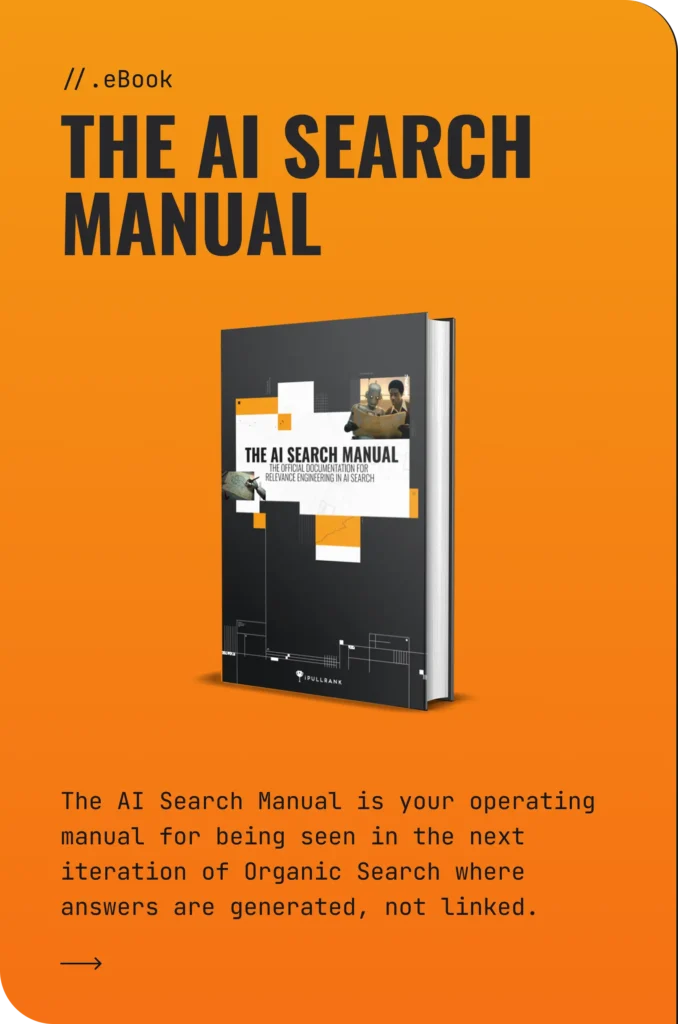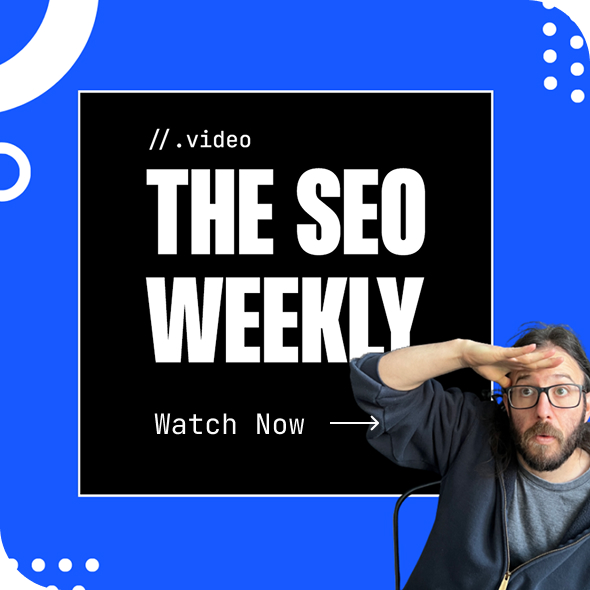It was a covert operation. Dressed in full espionage gear, I infiltrated the heart of Google’s data centers. I dropped from the ceiling to obtain the precious AI Mode data cargo. The most valuable data in the SEO world right now.
No. iPullRank has the privilege of working with SimilarWeb on AI Mode data analysis. In our initial report, SimilarWeb provided Elias Dabbas and our team with daily relative data points from over 100K AI Mode users between the timeframe of May 20th (AI Mode’s public launch date) to June 19th on the following metrics:
- Searches per session
- Referral rate
- Referral TOS mins average
- Referral pageviews average
- Sessions per user
- Average query length
- Users vs active days
- Referral share
Initially, only a few data providers are capable of capturing this data. But AI Mode (and other LLM-based datasets) are unique in how we analyze them. Due to the probabilistic nature of AI Mode and the limited insights into specific queries and search intent, we must maintain a high-level analysis.
Every search journey is going to be even messier to parse out as people start to use AI Mode. A search for a new bike for my daughter is going to look significantly different from your search for a mortgage for your house. Assuming that Google will continue to integrate hyperpersonal context into the search results, replicating specific topic sets may be a fool’s errand when you try to get too granular.
In other words, we’re looking for trends that can lead to informed speculation. Also, please note that we anticipate some overlap with traditional SEO results. Despite the different processes that get us to an AI-driven probabilistic result, that’s purely a layer of complexity on top of the way that Google determines the best answers based on the search.
Contextualizing AI Mode Data
Who is using AI Mode?
While we don’t have specific demographics, we can call out some fair assumptions. AI Mode is not the default version of search (and defaults matter).
When AI Overviews were released, they were deposited directly above organic search results. They took over significantly more digital real estate than the Featured Snippet, hijacking clicks and disrupting traffic. Francine Monahan reviewed more than 50 AI Overview studies over the past couple of years and revealed the impact of AIOs on search. There’s no way to turn AI Overviews off. Your normal, everyday searcher has been directly confronted with the AIO in over 50% of searches now.
It hasn’t negatively impacted Google’s Organic Search marketing dominance. Google’s demise has been vastly overstated.
Alternatively, for AI Mode, the current friction point for searchers is strong. To get to AI Mode, you would either need to click the icon on Google’s homepage on the desktop or app, click the AI Mode tab after a regular search, or click the link at the bottom of the AI Overview that recommends diving deeper into AI Mode.
The type of person who takes these steps for an AI Mode search is not going to be your standard searcher. In fact, SimilarWeb found that initial usage of AI Mode was under 2% of all searches.

- Who are the early adopters clicking into AI mode?
- How does their behavior potentially differ from that of the average Google user?
Keep in mind that someone who uses AI Mode is likely a tech enthusiast, a tinkerer who loves to try out new features on a digital platform, a marketer or SEO professional who needs to stay on top of industry trends, or someone who is more curious than most. Perhaps there are additional psychographic types, but for the context of this data, that’s not going to be everyone.
Early insights should be framed through this contextual lens.
Want to optimize for AI Mode? Check out the definitive post.
AI Mode Usage Insights
Let’s take a look at some of the most interesting data from the set. The biggest question for SEO and marketing teams right now revolves around traffic.
- Will there be less traffic from AI Mode compared to traditional Google Search?
- Do people visit more external sites in each session when using AI Mode compared to Google Search?
AI Mode vs. Google Search: The Referral Gap
When you zoom out, you can see a clear trend of significantly fewer clicks on average from an AI Mode session.
- 24% of Google Search Sessions result in a click
- 4.5% of AI Mode Sessions result in a click
Why would we see such a massive disparity?
Answer Completeness
- AI Mode may provide more comprehensive and satisfactory answers by anticipating future questions using the Query Fan-Out technique.
- If you get all of your answers, you’re less likely to seek further information from external sites. The reduction in clicks from the AI Overview presence supports this.
Question to explore:
Are the types of queries answered sufficiently by AI Mode typically informational or fact-based, where a single direct response is often sufficient?
User Intent & Curiosity
- People purely experimenting with AI Mode might be exploring the interface rather than actively seeking true answers to their questions. Less about the search and more about trying out AI Mode.
- People might be testing AI Mode’s capabilities. If they’ve never used a chatbot like ChatGPT or Gemini, they might be curious about what they can do.
Question to explore:
Is there evidence (e.g., very short or exploratory queries) suggesting users are experimenting rather than actively researching?
Design and UI Friction
- AI Mode has tested anchoring links within the generative output. They also exist less prominently in a side container compared to the traditional SERP layout.
- The interface discourages and obscures external links, making them less intuitive to click through.
Question to explore:
How does the visibility or prominence of external links differ between standard Google Search results and AI Mode?
Early Adopter Behavior
- As mentioned previously, AI Mode users are likely early adopters who are more technologically inclined and accustomed to finding answers without additional context.
- They might use multiple tools simultaneously (like ChatGPT) instead of clicking through multiple sources.
Question to explore:
Does the profile of early AI Mode adopters indicate a preference for self-contained answers or multi-platform research habits?
Perceived Trust and Authority
- Could there be an inherent trust for AI-generated answers from Google? Seems unlikely, but it would reduce their perceived need for external validation.
Question to explore:
Can trust levels or perception of authority explain differences in click-through behavior?
Reduced Commercial Intent in Early Queries
- People currently exploring AI Mode may be using fewer commercial or transactional queries, where clicking external sites is common.
- Traditional search is heavily used for transactional intent, naturally driving higher click-through rates. Same for navigational searchers. Why take the extra step to go to AI Mode for a navigational search when you’re simply trying to get to the brand’s website?
Question to explore:
Do queries in AI Mode significantly differ in terms of informational vs. commercial intent compared to standard search?
There are several reasons why clicks might be lower in AI Mode. Two recurring questions that would provide more insight:
- If we knew the query, would we see differences among query types?
- If AI Mode had been the default for Google Search for a while and everyone was familiar with using it, would we see significantly different behaviors?
The above graph is interactive, so you can hover over each data point to reveal the daily comparison. You can also remove the Google Search or AI Mode data to zoom in and view the high volatility of AI Mode referrals, as shown in the screenshot below.

Google Searches are steady, but we see more variability in AI Mode from 5.4% to 3.8% external clicks. I wouldn’t conclude that the declining click rate is indicative of a trend yet, but it’s worth keeping an eye on. And everything will change once this becomes the default in 6-12 months.
What about referral page views per session?
When we examine the average quantity of referral pageviews per session, we see two interesting narratives.
- 6 external clicks from Google Search per day
- 5.9 external clicks from AI Mode per day
Averaged out over the two months, the actual quantity of clicks is similar.
But when you look at the graph, you can see that Google Search is relatively stable. We observe a similar pattern, with more external clicks on weekends and consistent referral clicks throughout the week.
AI Mode is volatile. Without a given pattern, we see as many as seven clicks to only four.
The data is noisy early on.
What's next for AI Mode data trends?
Next week, we’ll share more of our insights from the initial AI Mode data provided by SimilarWeb, which Elias Dabbas has analyzed and displayed. They have been excellent partners.
We’re still cleaning the data, but you can expect to see a bombshell insight when we drop the longer report next week. If it holds, it will completely change the way you view how Google refers people from AI Mode.
What are your initial thoughts on AI Mode? Do you feel strongly about your own experience with it or the data presented here that might impact how you want to frame it for the future of your GEO and Relevance Engineering efforts?







